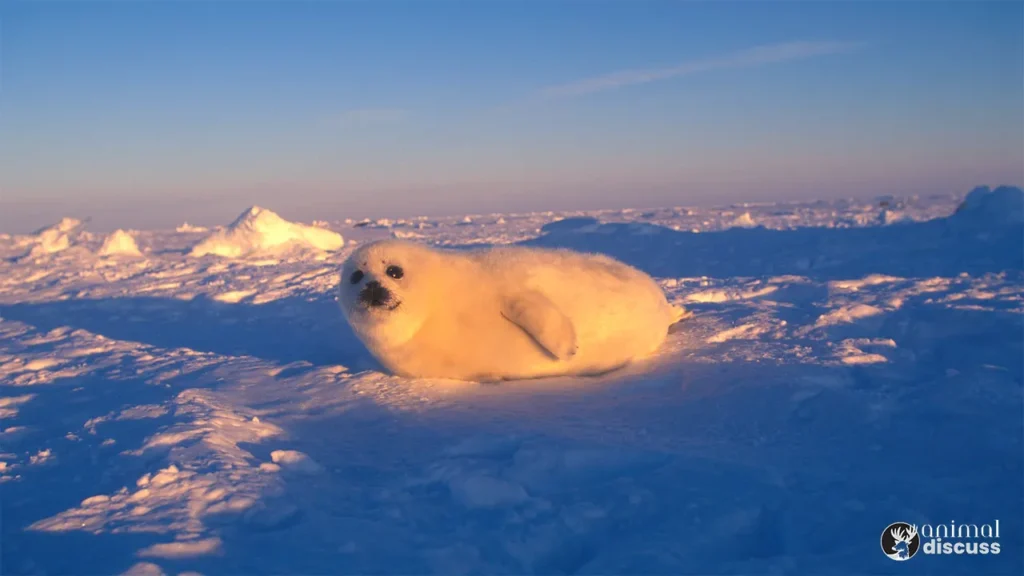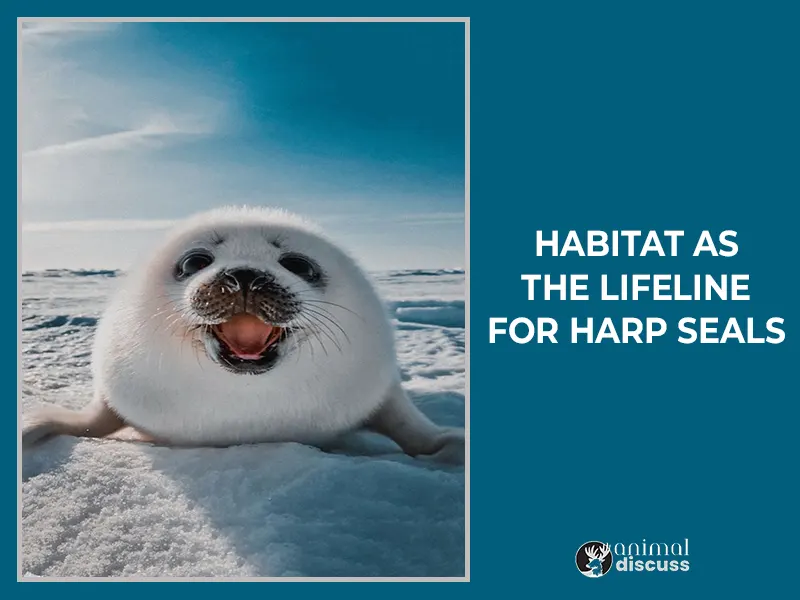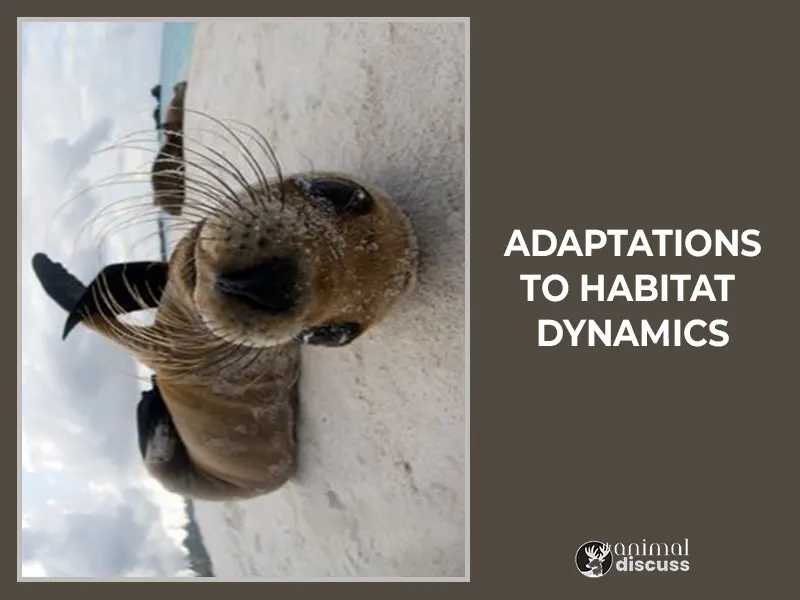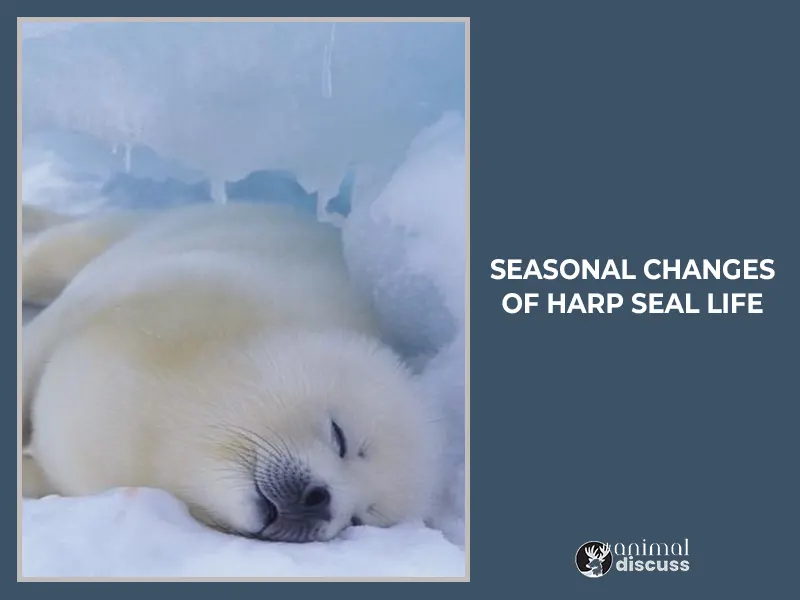Harp seals are astonishing Arctic inhabitants exquisitely adapted to seasonal ice floes and frigid waters. Their existence intertwines profoundly with the rhythmic advance and retreat of sea ice platforms.
These frozen expanses offer essential breeding sanctuaries and hunting grounds, along with protection from predators and shelter from relentless winds.
As climate change accelerates ice loss in their North Atlantic range, harp seals face escalating threats to their habitat and survival.

This article explores the intricate role sea ice plays across the harp seal life cycle. It details their reliance on this ephemeral environment for nursing pups, molting, resting, and more.
We’ll also examine how pollution, overhunting, and warming trends endanger these ice-dependent seals. By spotlighting their challenges and adaptations, we gain insight into conserving their unique polar niches for generations to come.
01. Habitat as the Lifeline for Harp Seals
Harp seals rely heavily on sea ice for various critical aspects of their lives. Let’s have a look at them –

A. Essential Resources
Harp seals rely on sea ice as a platform for essential activities like giving birth, raising pups, molting, and resting. Ice provides a stable and secure environment for these vulnerable life stages.
Additionally, the surrounding waters offer abundant food sources like capelin, cod, and shrimp, which are crucial for their diet.
B. Food Availability
The distribution of prey within the habitat significantly impacts the daily lives of harp seals. They are highly mobile and follow food sources as they move throughout the year.
This requires a complex understanding of the seasonal changes and variations in their environment.
Let’s explore how these masters of the icy expanse utilize their environment for their next meal.
- Strategic Outlook: Vast ice expanses serve as strategic vantage points for harp seals to scan below the icy surface. Their sharp vision aids in tracking fish and crustaceans, offering a bounty of potential prey.
- Tactical Edge: Dynamic ice edges create ideal ambush spots. Here, seals patiently await unsuspecting prey, utilizing the ice’s camouflage to launch surprise attacks.
- Submerged Stealth: Skilled divers and harp seals utilize natural ice holes as breathing spots while hunting. These openings, formed by shifting ice, allow concealed observation of prey.
- Beyond the Ice – Kelp Haven: Dense kelp forests harbor a vibrant ecosystem, providing seals with a rich array of marine life. Here, they navigate for diverse prey.
- Open Waters: When ice melts, seals venture into open waters, leveraging their agility to pursue prey across various depths.
- Coastal Bounty: During breeding, rocky coastlines serve as vital foraging zones, offering an assortment of invertebrates to supplement their diet.
Harp seals showcase remarkable dietary adaptability, tailoring their feeding tactics based on seasonal and habitat shifts. This flexibility underpins their thriving existence in the ever-evolving Arctic.
C. Breeding Grounds
Sea ice serves as a crucial breeding ground for harp seals. They congregate in large colonies on the ice to mate and give birth.
The stability and thickness of the ice are essential for pup survival, as they rely on it for protection and access to nursing mothers.
Let’s give you a more in-depth look –
#Birth Amidst Ice: During winter, amidst the expansive sea ice, expectant mother seals embark on an extraordinary annual journey. Guided by instinct, they navigate icy waters to reach their customary breeding grounds.
These stable ice floes offer a haven for birthing and nurturing their young.
#Camouflaged Safety: Newborn harp seal pups white fur helps to blend seamlessly into the snowy landscape, shielding themselves from predators like polar bears and arctic foxes.
#Nurturing Haven: Ice floes serve as a nurturing platform for mothers to nurse their pups. The thick ice layer shields them from harsh Arctic winds, ensuring the pups’ growth and survival.
#From Ice Nursery to School: Under maternal guidance, young seals learn to swim and navigate the icy waters—a critical step toward independent survival.
Young harp seals engage in playful antics across the ice floes, honing their skills and strength through playful chases and dives.
While breeding is pivotal, ice remains integral to several other facets of harp seal life. During warmer periods, ice floes offer a sanctuary for adult seals to rest and molt, shedding old fur for a sleek new coat.
#Strategic Hunting: Ice platforms afford seals a strategic advantage for hunting. They scout the waters for fish and crustaceans, launching precise attacks from above.
#Safety Retreats: In times of danger, seals quickly seek refuge on the ice, evading predators and finding safety on the frozen surface.
D. Shelter
Sea ice provides shelter for harp seals from predators like polar bears and orcas. The ability to camouflage themselves against the white backdrop of the ice further enhances their protection.
Let’s explore the diverse ways these ice-loving creatures utilize their surroundings to protect themselves from predators and the elements.
- Icy Sanctuary: These expansive ice masses serve as crucial escape routes from predators like polar bears and sharks. Swiftly hauling themselves onto these floes acts as a barrier, ensuring their safety.
- Ice Caves: Amidst harsh conditions, harp seals seek refuge in natural ice caves within floes, shielding themselves from biting winds and snowstorms.
- Elevated Watchtowers: Intricate ice ridges become advantageous lookout points for seals to scan their environment, maintaining vigilance and evading threats.
- Rocky Shores: During ice melts or breeding ventures, seals find shelter along rugged coastlines and islands. These terrains offer safety from tides, a haven for nurturing young.
- Kelp Hideouts: Within dense kelp forests underwater, seals find camouflage and protection while hunting or resting, blending seamlessly into their lush surroundings.
- Deep Dives: Their exceptional diving prowess allows harp seals to seek refuge in the ocean’s depths when threatened, finding sanctuary beyond the reach of predators.
If you are interested in more specific details on harp seal overview, kindly check out the article in my blog.
02. Adaptations to Habitat Dynamics
Thick Blubber
Harp seals have developed a thick layer of blubber for insulation in the frigid Arctic waters. This fat layer helps them maintain body temperature and conserve energy while hunting.

Camouflage
Their white fur blends in perfectly with the sea ice, providing excellent camouflage during molting periods and when protecting pups.
Powerful Swimmers
Harp seals are excellent swimmers and divers, allowing them to efficiently pursue prey and navigate through sea ice.
Seasonal Migrations
They exhibit remarkable adaptability, undertaking long-distance migrations every year to follow seasonal changes in food availability and ice conditions.
03. Seasonal Changes – The Rhythm of Harp Seal Life
Harp seals, adorned with playful elegance and distinctive spotted fur, sway in tandem with the Arctic’s rhythmic changes. Their existence embodies a fluid adaptation, harmonizing with the evolving environments and resources.

Here is a table summarizing the location of Harp Seals by season –
| Season | Location |
|---|---|
| Winter (February – April) | Breeding grounds in the White Sea, Newfoundland, and the Greenland Sea |
| Spring | Migrate north following the receding pack ice |
| Summer | Arctic, as far north as Jones and Lancaster Sounds in the Canadian Arctic and Thule in northwestern Greenland |
The fall location is not specific because harp seals are strongly migratory, with the northwest population regularly moving up to 4,000 kilometers northeast outside of the breeding season3.
Let’s explore how their lives align with the distinct seasons, shaped by their habitats and locations –
Spring
As winter retreats, pregnant harp seals journey to stable ice floes for breeding. These platforms offer secure sanctuaries for birthing and nurturing their offspring.
With warmer temperatures, older seals use elevated ice ridges to molt, shedding old fur for a sleek, fresh coat. Melting ice creates open water leads, inviting seals to chase fish and crustaceans in these newly accessible hunting spots.
Summer
Progressing through summer, seals track the retreating ice edge, accessing new feeding grounds brimming with vital plankton and fish. Seeking shelter in dense kelp forests, seals find safety and sustenance amid the rich underwater life.
For certain populations, rocky coastlines become nurturing breeding grounds, providing shelter from polar bear threats.
Autumn
As the Arctic winter approaches, harp seals migrate south to warmer waters in search of food. They continue to follow the availability of prey throughout the winter months.
Building fat reserves becomes a priority, driving seals to hunt in dwindling open water leads for survival through the coming winter. Congregating on ice floes, seals form communal resting areas, conserving energy and warmth for the approaching winter.
Winter
In the winter chill, seals rely on natural ice holes for air access during prolonged underwater stays, preserving energy and warmth.
With thick ice limiting hunting, seals rely on fat reserves, bracing for the scarce hunting opportunities during harsh winters. Winter fosters close social bonds among seals, providing solace and companionship through the Arctic’s dark nights.
Adapting seamlessly, harp seals navigate the Arctic’s seasonal tapestry, embracing diverse habitats and locations to sustain their lives.
Their dance through the seasons is a testament to the profound influence of habitat and location on these captivating beings.
Life Cycle by Location
Harp Seals are semi-aquatic marine mammals that spend most of their life in the sea but also go onto ice floes1. They are found in the North Atlantic and Arctic Oceans, and their survival is intricately linked to these environments.
Here is a detailed overview of the life stages of Harp Seals from a location perspective –
#Birth and Early Life (Late February – Mid-March)
Harp Seals are born between late February and mid-March on the pack ice in the southern reaches of their range. The major breeding grounds include the “East Ice” of Russia’s White Sea, the Greenland Sea’s “West Ice”, and the Northwest Atlantic.
#Weaning Period (Spring)
After weaning, which occurs when the pups are roughly 80 pounds, the mothers leave them for the company of males in order to mate. The pups then undergo a lean period of fasting on the ice for up to six weeks, surviving off their blubber stores.
#Spring Migration (Spring)
During spring, Harp Seals migrate north following the receding pack ice3. They swim more than 3,200 kilometers to reach the Arctic.
#Summer Residence (Summer)
In the summer, Harp Seals move to areas with more open water, such as the Arctic, as far north as Jones and Lancaster Sound in the Canadian Arctic and Thule in northwestern Greenland.
#Fall and Winter
The exact locations of Harp Seals during fall and winter are not specified in the sources I found.
However, Harp Seals are known to be strongly migratory, with the northwest population regularly moving up to 4,000 kilometers northeast outside of the breeding season.
04. Impact of Habitat Alterations on Harp Seal Life
Harp seals are native to the northernmost Atlantic Ocean and Arctic Ocean1. They are found in the cold waters of the North Atlantic and Pacific oceans.
Their habitat ranges from the ice floes of the Arctic to the coasts of Greenland, Russia, and Norway.
There are three recognized populations of harp seals based on geographic distribution as well as morphological, genetic, and behavioral differences:
- Barents Sea
- East Coast of Greenland
- Northwest Atlantic Ocean
In the winter, these seals give birth on the ice and spend most of their time in the water, hunting for fish, squid, and crustaceans.
However, the habitat of harp seals is greatly at risk due to climate change. With warming temperatures eroding vital icy birthing grounds, harp seal pups face escalating threats.
Their frigid North Atlantic habitat has undergone pronounced winter sea ice decline over the last 30 years due to climatic shifts.
This dramatic reduction of frozen ocean platforms essential for rearing young has substantially heightened mortality rates across newborn harp seal populations in recent decades.
As the backbone of future generations, these vulnerable pups encounter ever-more precarious starts to live as their natal icy shelters melt away.
Warming in the North Atlantic Ocean has decreased winter sea ice and increased the death rate for baby harp seals over the past three decades.
Winter sea ice cover in harp seal breeding grounds has decreased up to 6 percent per decade since 1979. This has made it tougher for harp seals to breed and rear their young to adulthood.
The changing climate is accelerating the start of the spring ice melt, reducing the area covered by ice during February and March – months when female seals use thick sea ice as a platform to birth and nurse their young.
In addition to climate change, other threats to harp seals include overfishing, ghost fishing gear, and marine plastic debris. These factors are all having a greater impact on fish stocks than seal predation.
Pollution and Human Activities
Industrial and agricultural activities can contaminate the oceans, leading to the accumulation of harmful chemicals in harp seals’ bodies. These toxins can harm their health and immune systems, impacting their ability to survive and reproduce.
Pollution is another major threat to harp seals. They frequently are hit and killed by boats. Also, they often experience the detrimental effects of oil spills.
When oil spills, the oil gets all over their coats and ultimately brings upon fatal consequences. These disturbances caused by fishing equipment can also be perilous to harp seals.
Plastic pollution is also a significant threat. Harp seals often ingest microplastics, which have toxic chemicals that can increase the chance of disease and affect reproduction.
They also often get entangled in plastic waste, which can lead to a gruesome death.
Human activities also have a significant impact on harp seals. Us, humans have hunted harp seals since the 17th century, seeking their flesh, pelts and oil.
The juvenile stage harp seals are prized for their soft, smooth and pure white coats, which have long been major hunting draws.
Different conservation and protection missions are in place to defend harp seals as a species, however, thousands and thousands of them are killed by people annually.
Habitat alterations, particularly those caused by climate change, are having a significant impact on the life of harp seals.
These changes are affecting their breeding grounds and food sources, posing a serious threat to their survival. Pollution and human activities are also contributing to the threats faced by these seals.
Conservation and the Future of Harp Seal Habitats
The conservation of the Harp seal (Pagophilus groenlandicus) is becoming increasingly important as the species faces a number of threats in its Arctic habitat.
Over-hunting has been a significant issue, with harp seals being hunted by humans for their fur, oil, and meat for centuries.
However, the most pressing concern for the future of harp seals is climate change.
Harp seals depend on ice for raising their pups, and they are likely to be greatly impacted by melting sea ice.
The deterioration of their critical ice habitat due to climate change, along with other threats such as overfishing and marine plastic debris, are all having a greater impact on fish stocks than seal predation.
Despite these challenges, there are an estimated 4.5 million harp seals in the wild, leading them to be considered a species of “least concern,” according to the IUCN5.
However, their status could change if the threats they face are not addressed effectively. Conservation efforts are crucial to ensure the survival of these remarkable creatures and the preservation of their unique habitats.
Conclusion
For over two million years, harp seals have migrated across the ever-shifting icescapes of the North Atlantic and Arctic.
Their evolutionary journey showcases remarkable resilience and synchronization with the seasonal expansion and dissolution of frozen platforms on their nursing, breeding and hunting grounds.
Safeguarding harp seal populations will require national and global efforts to curb emissions while also expanding protected polar habitats.
With a committed conservation focus, we can ensure the harp seal’s lyrical aquatic dance graces northern latitudes for millennia more.
References:
- https://animals.mom.com/humans-impact-harp-seals-7816.html
- https://www.ifaw.org/journal/climate-change-threats-seals
- https://live.oceanconservancy.org/wildlife-factsheet/harp-seal
- https://animalcorner.org/animals/harp-seal
- https://sciencing.com/life-cycle-harp-seals-6735960.html
- https://www.scientificamerican.com/article/climate-change-life-harder-baby-harp-seals
- https://www.fisheries.noaa.gov/species/harp-seal

